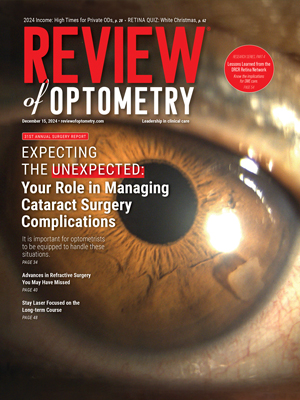| This study has suggested that a larger baseline axial length in highly myopic eyes increases the chances of posterior staphyloma onset and progression. This illustration from the study shows the pattern of progression from (a) longitudinal elongation of the eye to (b) transversal elongation of the posterior pole to (c) posterior staphyloma. Photo: Li H, et al. Eye Vis (Lond). 2024;11(1):45. Click image to enlarge. |
A great deal of current research has focused on preventing the onset of myopia, but few studies have investigated how to slow the progression of myopic complications. If biomarkers can be found to predict such complications, it would be possible to intervene early and prevent further vision loss. With the development of OCT angiography (OCT-A), blood circulation in the fundus has become a quantifiable parameter, which researchers in China believed could provide a factor for exploring the pathogenesis of posterior staphyloma, a typical sign of pathologic myopia. They observed the characteristics of macular curvature and macular microcirculation over time in highly myopic eyes with posterior staphyloma, aiming to investigate the characteristics of the progression and risk factors of the condition.
The team noted that changes in choroidal microcirculation can be the risk factor for diagnosing the presence of posterior staphyloma and for predicting its progression. In their preliminary findings, the team also discovered the fact that the posterior pole of the fundus expanded longitudinally, then transversely and finally appeared as a localized bulge of the eyeball characteristic of posterior staphyloma.
This longitudinal case-control study, published in Eye and Vision, enrolled 122 eyes of 122 patients—64 patients with posterior staphyloma and 58 patients without. Participants underwent OCT-A and clinical examinations at least twice, and those followed for at least one year were included in the analysis. Logistic regression analysis and machine learning were applied to explore the risk factors for the condition and its progression.
Patients in the posterior staphyloma group exhibited faster growth rates of spherical equivalent refraction (SER), axial length (AL), curvature index and posterior scleral height, as well as higher loss rates of choriocapillaris perfusion area, choroid perfusion area and choroidal vascularity index (CVI).
The baseline SER (odds ratio; OR = 0.275), baseline subfoveal scleral thickness (OR = 0.198), baseline posterior scleral height (OR = 19.282) and foveal choroidal vascularity index changes per year (OR = 0.062) were determined to be the risk factors for posterior staphyloma. Baseline AL (OR = 1.752), parafoveal choroidal thickness changes per year (OR = 0.910), foveal retinal vascular density changes per year (OR = 1.110) and foveal choriocapillaris perfusion area changes per year (OR = 0.807) were considered risk factors for the posterior staphyloma progression.
“Our preliminary findings suggest that there perhaps exists a compensatory stage in the evolution of posterior staphyloma that enables the posterior pole of the eye to expand laterally toward the periphery of the macula to resist excessive elongation of the AL,” the study authors wrote in their paper.
These findings demonstrated a significant role of microcirculatory changes in the progression of posterior staphyloma for the first time and provided new insights for predicting the deterioration of posterior staphyloma in the future and for timely intervention.
“When patients are predicted to be at high risk of posterior staphyloma progression, clinicians can promptly intervene with enhanced interventions or even perform surgery such as posterior scleral reinforcement surgery to prevent further aggravation of the condition as well as the development of other myopic complications,” the researchers noted.
| Click here for journal source. |
Li H, Gao N, Li R, et al. Microcirculatory parameters as risk factors for predicting progression of posterior staphyloma in highly myopic eyes: a case-control study. Eye Vis (Lond). 2024;11(1):45. |


